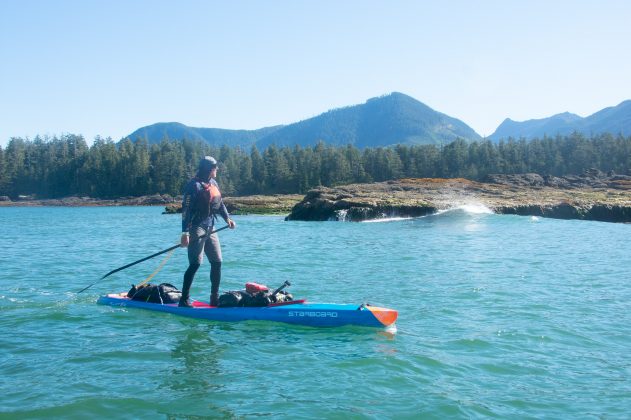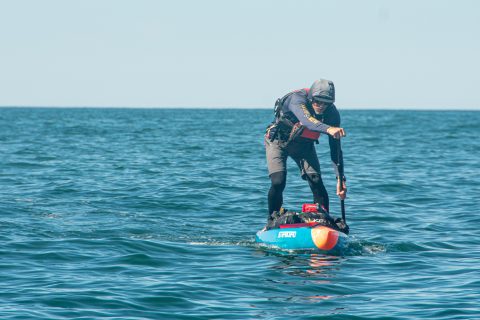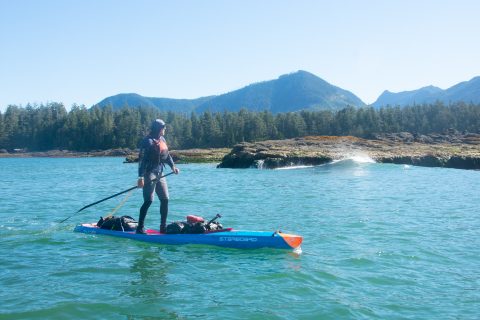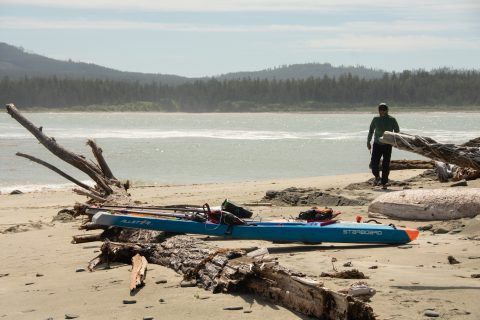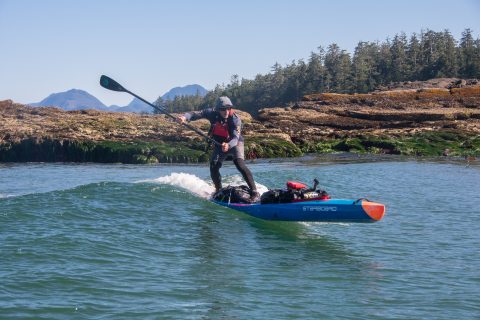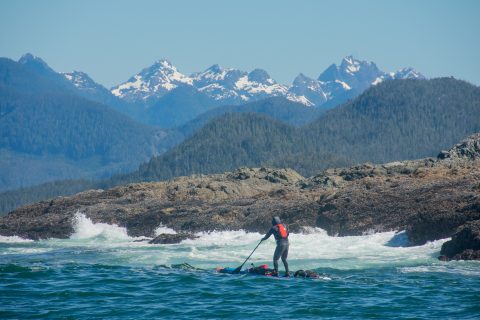NATURE SETS THE SCHEDULE
BRUCE KIRKBY
Bruce Kirkby and Norm Hann set their sights sights on rounding the hectic waters around the Hesquiat Peninsula, on the outer coast of Vancouver Island!
Words: Bruce Kirkby
Photos: Norm Hann and Bruce Kirkby
Prelude
During the depths of winter, Norm Hann and I set aside ten days for a paddle expedition in June, on the outer coast of Vancouver Island. For almost a decade, we have been picking our way around one challenging headland after another, slowly linking up the entire Canadian west coast. This summer we had our sights set on rounding Hesquiat Peninsula, an immense low-rock promontory, jutting in the Pacific, battered by northwest gales, separating the protected waters of Nootka Sound from Clayquot.
Weather spoiler
Coastal weather patterns remained notably unsettled throughout the chilly spring, and as our expedition approached, one low pressure system after another spun across the Pacific, crashing onto Canada’s desolate outer coast. On our planned day of departure, offshore buoys reported gale force winds and building 8m swell. There was no point driving down muddy logging roads to the remote put in—we’d be pinned to shore for days, huddled in a tent, lashed by winds and rain. Instead we waited at home, watching the days tick past.
It took a full week for the storm to ease. That left only three days before Norm had to be back at work as a SUP guide. And I had to return to a construction site on a remote island. If the starts aligned, we still might be able to squeak around Hesquiat Peninsula before that, but it would take some very long paddling days and perfect conditions Was it even worth even going at this point? We decided to give it a shot.
Green light
Launching from a recreational camping site, in the protected waters of Nootka Sound, the day began with pelting rain. Above us, rocky coastal peaks slipped in and out of low cloud. Our loaded SUPs slide effortlessly across glassy waters.
With every passing hour, the outer coast neared, and so did the distant roar of surf. The sea state had subsided slightly, with nearby lighthouses reporting 6 m swell–still an enormously powerful ocean.
Nosing cautiously though an archipelago of islands perched in the mouth of Nootka, we eventually came face to face with the aftermath of the storm. Dark lines of swell marched in from the open ocean, traveling at immense speed. Paddling ahead, Norm was hoisted skywards by each successive monster, before disappearing from sight behind it. By the time I was balance atop the mountain of dark water, he was far below me, in the trough ahead.
Dealing with the elements
Slowly, carefully, we inched closer to Burdwood Bay, perched near the start of Hesquiat Peninsula. The bay was a mess of foam and whitewater, with overhead surf breaking across the entire beach. But a tiny pocket cove near the mouth offered safe harbour, protected by a jumble of offshore rocks. Nonetheless, waist-high breaking waves tossed us and our boards up the pebble beach with humbling power.
Perched on the edge of the open Pacific, happy to have left the hectic pace of the modern world behind, we set up a small tent, and cooked dinner while watching a pair of eagles wheel and cry in winds overhead.
The next morning dawned clear. With blue skies and fair winds, our plan was to inch our way down the north shore of Hesquiat. The swell had eased to 3m overnight—which still makes for committing paddling. We wound our way through rocky islets dotting the coast, mindful of the powerful waves crashing again offshore reefs. By noon we’d reached Escalante Island and took shelter on a small beach in the lee. There were no more protected landing spots ahead. From here we’d face fifteen kilometers of surf-riddled coast before the first sheltered bay.
Stranded
As we gulped down a quick lunch of crackers and landjager sausage, sand started to swirl around us. The marine forecast had called for light winds, but soon the island was being buffeted by 25 knot gusts. Then 35 knots. The sea was soon covered in whitecaps. We weren’t going anywhere.
Learning to travel safely on the open coast–particularly in a craft as exposed to sea state as a paddleboard—requires the complete surrender of human-imposed schedules. In general, one should get up early, every day, and travel as far as you safely can while the conditions allow, and before afternoon thermal winds build. Whenever foul weather and strong winds descend, one must wait patiently, for hours, days, even weeks. There is no other option. No one can out-muscle the ocean. The ocean is always in charge.
So, Norm and I stayed put, watched nesting oystercatchers scream and hop along the rocky shorelines. We read. Beachcombed. Napped. Surfed knee-high waves that broke on the protected beach. Ate all our snacks. Felt the sun on our cheeks. And wind in our hair. Slept the deep, unbroken sleep of children.
Retreat
And the next day, with our hopes of rounding Hesquiat dashed—at least for the time being—we returned to our car. But was the expedition a failure? Should we have stayed home? I’d argue not. Every journey into the wilderness is an opportunity to learn and be refreshed. Norm and I took away many lessons we’ll apply on future journeys. But more fundamentally, SUP touring—and every other outdoor venture—is never about the accomplishment, but instead the experience.
So, my advice is say yes, and go, no matter how short the window. You’ll only regret the trips you didn’t take.

